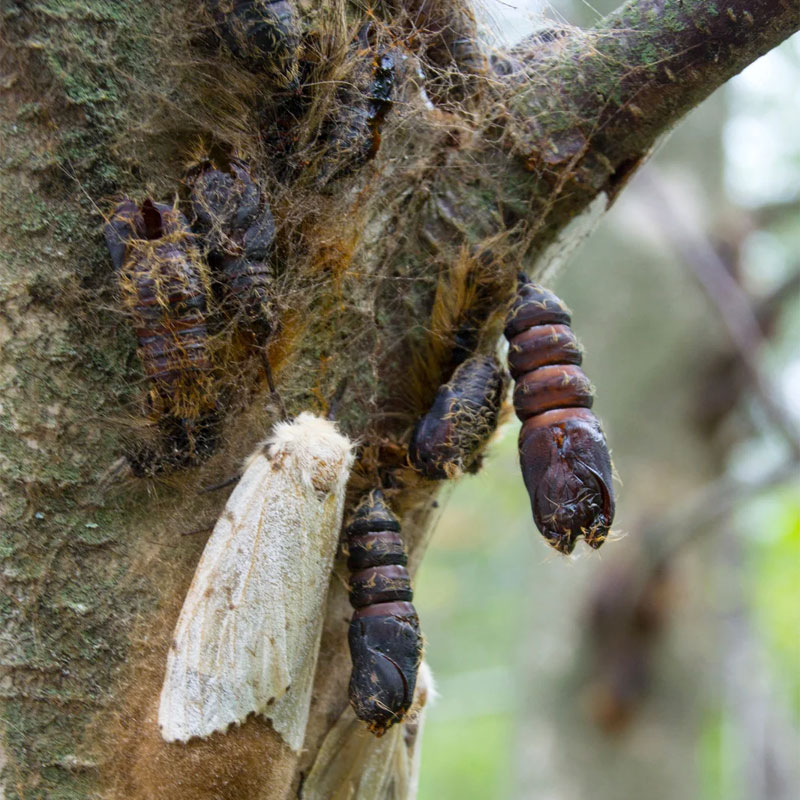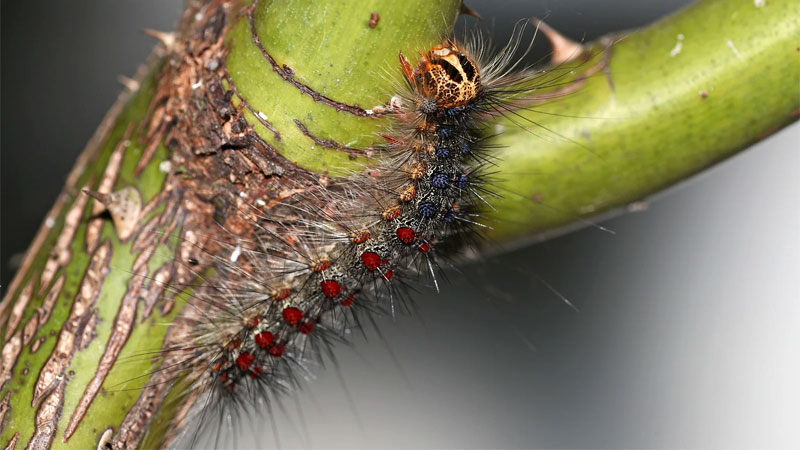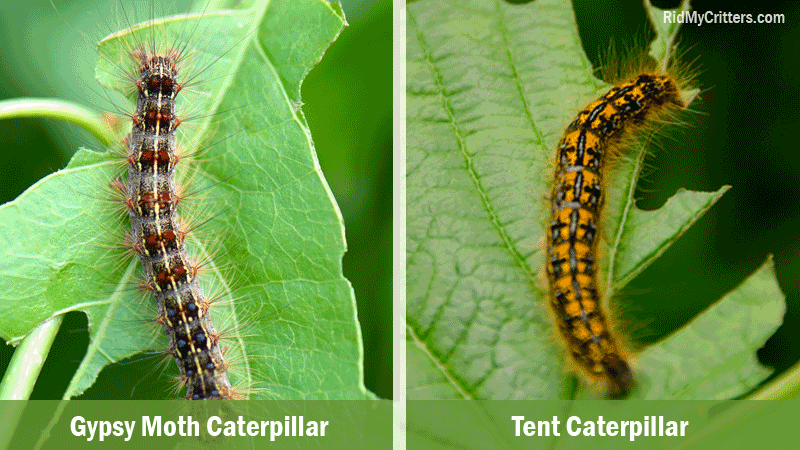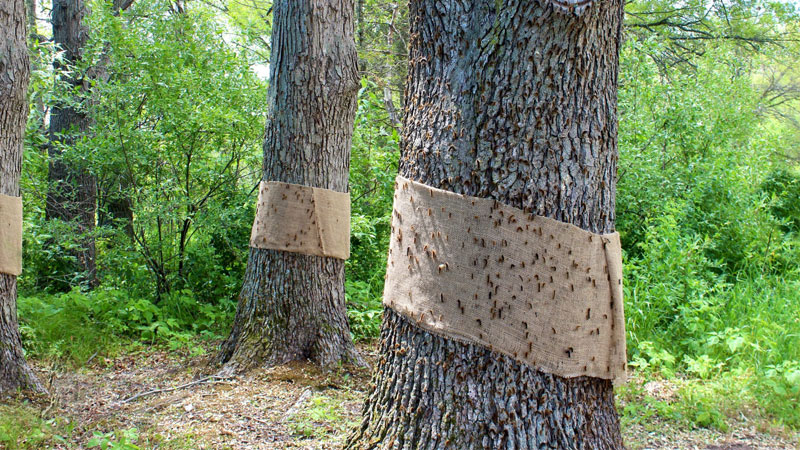The term gypsy moth is one that has an odd reputation in pop culture. Because of the destructive power of their caterpillars, gypsy moths are often associated with death or decay in horror tropes, much like flies.
They’re often featured in promotional posters for suspense and horror films, as well as other media. In recent years, they’ve even become embroiled in political campaigns (we’ll touch upon that briefly later on).
But there’s a lot more to these moths beyond being a popular trope or unwitting villain. They have a rather fascinating, albeit brief lifecycle, and one could spend years studying how they fit into the ecosystem.
Of course, when you spot them in the backyard munching on your trees, the only real interest is in getting rid of gypsy moths. So here’s what you need to know about gypsy moths, what they are, what they do, and how to get them off your property.
Getting to Know Gypsy Moths
These tiny terrors have quite the reputation, but is it deserved? Interestingly, the adults take the blame for the caterpillars’ behavior, but are they also a problem? Let’s take a (somewhat) deep dive into the fascinating world of the gypsy moth and examine these questions and more.
Disclaimer: A Note on the Political Name Game
We will be mostly discussing the North American gypsy moth (AKA the European gypsy moth), as it is the only subspecies to have a permanent presence in North America. However, it should be noted that there is some political controversy over the common name that means you may or may not find these moths in some popular listings.
In 2020 and 2021, many US organizations began a politically-fueled campaign to rename anything anyone might find even mildly offensive. This included removing the names of important people from buildings, destroying statues, and - you guessed it - even renaming critters and critter-watching organizations.
The Entomological Society of America was one such group to join the name game, and gypsy moths were among their targets. In 2022 they replaced all mention of gypsy moths in their database with a new name “spongy moth”.
While some organizations in the US have also adopted this new name it should be noted that the name gypsy moth remains the de facto throughout the rest of the world, as well as throughout much of the US. We here at RMC prefer to focus on the science of critters, not political rhetoric. Therefore, we will be sticking to the (almost) universally accepted common name of gypsy moth in this article for the sake of accuracy.
What Does a Gypsy Moth Look Like?
Thankfully, there’s no controversy over what gypsy moths look like – at least, not the adults. Gypsy moth caterpillars begin their lives around May at a very tiny size that can make them difficult to identify.
They start their lives off as completely black and seemingly identical to many other caterpillar species. Their bodies are light enough that they’re able to disperse on the wind, although they keep close to the egg cluster if temperatures are below 45 degrees Fahrenheit or if it’s rainy.
However, by July, they’ve grown large enough that the bristle-like setae can be seen along its entire body. They’ve also now developed two rows of colored bumps running down their backs, with forward five pairs being blue and the rear section of six pairs being red. These easily make them distinguishable from similar species such as the spiny elm caterpillar.
The adult stage is also quite interesting, with the male moths being very different in appearance to the females. The males have multiple shades of brown with a bark-like pattern on their wings, as well as feathered antennae. The forewings measure just under an inch long.
Conversely, the females are whitish with brown marks to resemble bark ripples and have thin antennae. They’re much larger than the males, with forewings measuring around 1-3/8 inches long.
Related: What Does a Baby Moth Look Like?
Gypsy Moth Life Cycle
Gypsy moth eggs are laid in late summer and develop in about a month. However, instead of hatching, the eggs then enter diapause until spring. Eggs clusters are most commonly laid on trees buc nca also be found under rocks, in foliage, ro even in vehicles – as long as it’s a sheltered spot.
These eggs are manila colored with hairs that have similar effects to those of the caterpillars and the clusters generally measure 1-1/2 inches long and 3/4 inches wide. After approximately eight to nine months, the larvae will reawaken and chew their way out of the egg casings.
By this point, it’s may and the emerging larvae are a tiny 0.12 inches long. They’ll go through five (males) or six (females) instars during this stage, reaching a final length of between 1 -15/16 and 3-9/16 inches before entering the pupal stage in early July.
The pupal stage only lasts 14 to 17 days before the adults emerge. Pupae are often made from sewing a leaf’s edges together, although the pupae is occasionally left uncovered and hanging.
When the adults emerge, it’s a race against time, since they can drink but lack any mouthparts. The female releases a powerful pheromone that begins waning on the third day.
Since the females don’t fly, it’s not uncommon to see males flying up and down trees in a zig-zag pattern trying to catch their scent. It only takes 10 minutes for insemination, but the copulation process takes up to an hour overall.
Males are able to copulate with multiple females, although this is rare. Fertilized females will lay around 500 eggs. Both males and females will die after about a week.
One important note: These times are all approximate, as some minor variation has been observed as a result of population and environmental conditions.
Speaking of the Weather…
Temperature and moisture play a huge role in gypsy moth populations. Unless sheltered, the eggs cannot survive a temperature drop to 16 degrees. Meanwhile tropical heats of over 90 degrees will boost their activity and metabolism.
Rain plays another major factor, as earlier instars are prone to drowning. This is why the caterpillars will often remain huddled on or near the egg cluster if it’s particularly wet weather. However, strong gusts of wind can end up dispersing the caterpillars.
Where Did Gypsy Moths Originate?
The North American gypsy moth is actually the same as the European gypsy moth (Lymantria dispar dispar). The Asian Gypsy moth has diversified into a separate subspecies (Lymantria dispar asiatica), and there is also a Japanese-specific subspecies, Lymantria dispar japonica which has never been found in North America thus far.
L. d. dispar was first discovered in North America in 1869 and quickly became invasive. L. d. asiatica was first seen in British Columbia in 1991 and has made a few attempts to gain a foothold in the US.
Read Also: What Are Mothballs Used For?
What States Are Gypsy Moths Found In?
The North American gypsy moth gained a foothold in Massachusetts in 1869. Since then, their range has spread to encompass all of New England. They are commonly found in:
- Connecticut
- Delaware
- Idaho
- Illinois
- Indiana
- Maine
- Maryland
- Massachusetts
- Michigan
- Minnesota
- New Hampshire
- New Jersey
- New York
- North Carolina
- Ohio
- Pennsylvania
- Rhode Island
- South Carolina
- Vermont
- Virginia
- West Virginia
- Wisconsin
Additionally, the Asian gypsy moth was discovered in (and quickly eradicated from) Washington, Oregon, and North Carolina. There have been sightings of gypsy moth males in numerous other states, including Hawai’i, but no confirmed colonies.
Gypsy Moth Damage
The caterpillars have a voracious appetite that grows as they do. They begin as diurnal feeders, but become nocturnal at the fourth instar. They’ll begin with the leaf hairs and munch their way into the leaf’s flesh.
During the final week or so of the larval stage, gypsy moth caterpillars will consume 90 percent of their total diet. This means a full-grown tree can be stripped almost overnight during a major infestation.
The effects of a large infestation can be horrifying, although these moths are rarely responsible for the deaths of trees by themselves unless the tree has been defoliated three years in a row. Instead, the defoliation weakens the plant and makes it susceptible to a range of other pests and diseases.
Are Gypsy Moths Harmful to Humans?
Generally speaking, gypsy moths are harmless to humans. However, they have tiny hairs that can easily stab you if you attempt to touch one.
These are prominent in the larval stage and sometimes can be dislodged and carried on the wind to spear unsuspecting victims during larger infestations. If “stung” by the hairs, it can produce pain, irritation, or even some swelling.
Known as lepidopterism, this skin irritation doesn’t last long but has often been compared to poison ivy in terms of intensity. Thankfully, it doesn’t spread like the effects of poison ivy do.
Can They Bite?
Contrary to popular belief, Gypsy moths (and most moths, actually) don’t bite in either caterpillar or adult stage. The misconception comes from people having reactions to the hairs on a gypsy moth caterpillar.
Gypsy Moth vs Tent Caterpillar
There are a few ways to tell these two species apart. One quick method is the fact that tent caterpillars only target aspen, birch, elm, maple, and oak trees with a few rare exceptions. Gypsy moth caterpillars, on the other hand, will widely attack over 500 different trees. So if your apple tree is infested, you can rule out tent caterpillars.
Another way to tell them apart is with their markings. Mature gypsy moth caterpillars have distinctive spots while tent caterpillars have a stripe down their back. Finally, tent caterpillars build silken “tents” while gypsy moth caterpillars rarely use silk.
Getting Rid of Gypsy Moths
There are many ways to get a gypsy moth infestation under control, although some might be easier to accomplish than others, depending on where you live and the extent of the infestation.
Gypsy Moth Traps
Best used to fight the adults, products like Catchmaster Tree Shield and Tred-N0t Slippery Caterpillar Tape use pheromones to attract adult moths which then get stuck on the sticky surface.
These will need to be replaced every month or two but are otherwise exactly what you would expect from sticky traps.
Pesticides
When used responsibly, there are a number of pesticides that can help fight a gypsy moth infestation. Products containing Spinosad (like this one) are generally effective, but Natural Guard’s Caterpillar Killer Spray is also commonly used.
Chemical pesticides containing pyrethrin are fast acting but may affect beneficial insects. Or you can go for fully organic, slower sprays such as those made from horticultural oils.
Natural Predators
Contrary to popular belief, birds aren’t major predators of gypsy moths. The black-capped chickadee is known to feed on the eggs as well as other life stages. Blue jays, catbirds, eastern towhees, European robins, northern orioles, and red-eyed vireos are known to feed on the larvae and adults, although they have limited effects once an infestation has become widespread.
On the other hand, predatory wasps are a major ally against gypsy moths. Trichogramma minutum are especially useful and can be purchased online. The wasps are able to lay their eggs inside the gypsy moth eggs, despite the spines.
Once the egg hatches, the wasp larva will feed on the moth larva. This species also aids in controlling other caterpillar threats such as armyworms, bagworms, borers, and cutworms.
Many other parasitic fly and wasp species areknown to prey on gypsy moth eggs and larvae as well.
The forest caterpillar hunter (Calosoma sycophanta) is a ground beetle native to Europe that was imported to New England in 1905 to help deal with the gypsy moth problem. While not as impactful in dense populations, this beetle can keep a smaller population under control and will continue to feed on their prey after reaching adulthood. They’re also known to feed on other unwanted caterpillar species.
Finally, if you don’t mind sharing your yard with rodents (and don’t suffer from musophobia), mice and their relatives are known to consume moths and moth larvae that get too close to the ground. The northern short-tailed shrew and white-footed mouse are two notable examples.
See Also: What Are Bed Worms and How Do You Get Rid of Them?
Neem Oil
Using a combination of neem soil soaks and foliar sprays can really cut down an infestation, and not just gypsy moths. Neem foliar sprays are slow-acting contact killers that may work against the early instars as well as adults.
Meanwhile, neem soil soaks are absorbed by the plant and become a systemic insecticide that affects any piercing or chewing pest, such as aphids, locusts, mealybugs, and – you guessed it – caterpillars.
You’ll need to apply the need at dusk or dawn, so there’s minimal risk of harming beneficial insects. The foliar spray must be applied every other day for at least 14 days, while the soil soak should be applied every two weeks. The best part is, you can apply the spray every two weeks or the soak every three weeks as a preventative.
Pathogens
Gypchek is a natural pesticide which uses the Lymantria dispar multicapsid nuclear polyhedrosis virus (LdMNPV) as its active ingredient. This pathogen kills and disintegrates the first instar as it emerges from the egg and can spread out to also affect other larvae nearby.
Its success rate is very high, although it can leave a smell from the decaying larvae. Streptococcus faecalis is another good choice of pathogens with a high success rate against the larvae.
Our old friend Bt (Bacillus thuringiensis) is yet another effective killer. This bacteria is well known for killing caterpillars if ingested and is readily available. It works best when applied in the evening while the caterpillars are still young.
Scrape Away
Keep an eye out for the egg clusters as you perform maintenance on your trees. If you see a cluster, use a paint scraper to gently remove it into a bucket of soapy water or a container to burn them in. Be sure to wear gloves to minimize the risk of accidental contact.
Preventing Gypsy Moths
Prevention is always the best medicine (besides laughter), and while you can’t completely prevent gypsy moths from invading your property, there are some things you can do to reduce the risk.
Clean House
While it won’t prevent them from laying eggs in your trees, regularly cleaning up any fallen debris and pruning away dead branches or stumps can greatly reduce the amount of sheltered areas for females to hide their egg clusters. This can also help keep a lot of other pests away.
Plants That Gypsy Moths Dislike
While gypsy moths love plants such as roses, there are a lot of other flowers and trees they’ll only attack during a major population explosion. Try planting the following if you’re in an area prone to gypsy moth infestations:
- American holly
- American sycamore
- Ash
- Balsam fir
- Black walnut
- Butternut
- Catalpa
- Cedar
- Flowering dogwood
- Mountain laurel
- Rhododendron
- Tulip-tree
- How to Get Rid of Hawks - March 8, 2024
- How to Get Rid of Pill Bugs (Rolly Pollies) - March 1, 2024
- How to Get Rid of Groundhogs (Woodchucks) - February 5, 2024

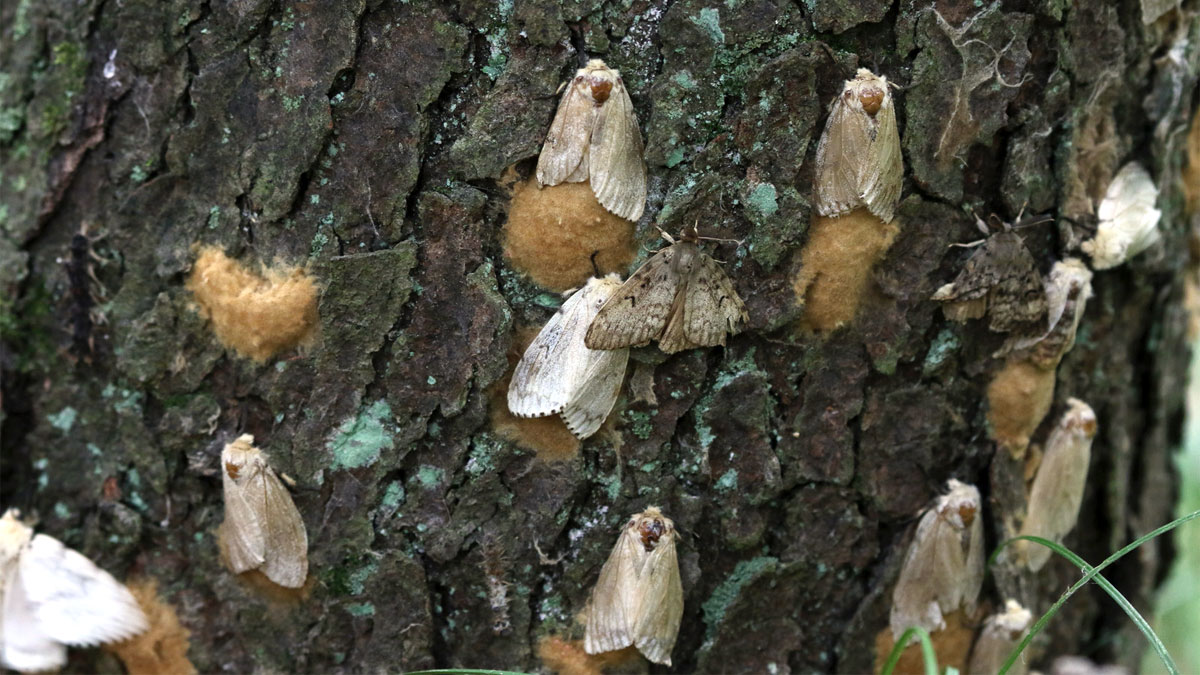
 Just tell me how to get rid of ’em.
Just tell me how to get rid of ’em.
